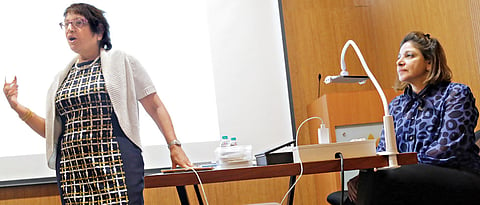

Sister duo Binaifer Karanjia and Jasmine Jehangir, certified Zentangle teachers, tell us that Tangleations, an art therapy, helps you de-construct daily life problems and deal with them in a better way
Ever thought of tangling your life? With the amount of stress we all carry with ourselves every day owing to our hectic lives, hundreds of deadlines, work pressures, family commitments and social obligations, life becomes completely tangled at times, we forget to deal with issues in an objective and organised manner, often complexing it further.
This is the time when dots and lines can rescue you. Yes! Tangling is an easy-to-learn, fun, and relaxing way of creating non-representational art. By learning how to draw patterns which are broken down into their elemental or destructured forms, the mind goes into a deeply focussed state. The participant needs to have no previous art background at all, and the beautiful art produced is quite simply the result of a combination of dots, lines and orbs.
Taught by the sister duo Binaifer Karanjia and Jasmine Jehangir, Certified Zentangle Teachers, Tangleations, their art, is about helping you uncover the true benefits of Zentangle, a technique patented by Rick Roberts and Maria Thomas in the US. (The word Zentangle too is copyrighted by Rick and Maria). It has now become a popular and accepted format of art therapy across the world and there are only 11 Zentangle Certified Teachers in India.
“It is not an art class,” insists Karanjia, as she teaches us some simple designs on a square piece of paper called a tile. “Doing this for a while puts you in a state of flow. The stress in your mind takes a backseat since your frontal cortex is occupied in tangling. This was proved in a scan that showed very little activity by the temporal lobe while a person is engaged in tangling,” she explains. This occurs because the frontal cortex of the brain is highly engrossed in the repetitive task of drawing these patterns to create seemingly complex formations. It is because of the repetitive and simplistic complexity of the process that the temporal lobes of the brain, which gives us our sense of time and space, almost switches off, leading to states of deep concentration and focus. The Indian traditional forms of meditation, call these states advanced state of dharana (deep focus) or dhyana (deeper states of concentration).
“Zentangle teaches us how to achieve such blissful states with simple strokes of a pen. And it is because the mind has moved to these relaxed modes, the distractions of the outer world get cut off, leading one to deeper states. And here begins the magic and the myriad benefits of tangling,” says Jehangir. It’s like sweeping your brain off all the stress, she adds.
Karanjia and Jehangir have been conducting tangling workshops in Pune since October 2017 and have got around 50 students certified. These include doctors, nurses, care-givers, retired personnel, students, working professionals and artists.
Dr Sanjay Phadke, a neuropsychiatrist at Jehangir Hospital has intensively studied the effects of tangling on the human brain and has documented evidence from PET (Purpose, Procedure and Risks) scans. His research shows that the temporal lobe is indeed inactive while practising the method. In a paper he has authored, which will soon be published, Dr Phadke contends that from the perspective of neuroscience, the brain activity while drawing a pattern bears many similarities to meditative practises as it activates the flow state. “Drawing tangles involves focus and disengagement from intrusive thoughts and emotions, and leads to a pleasant flow experience,” says Phadke. “Our preliminary work involving sophisticated assessment of the autonomic nervous system as a marker of these brain states, when the person is drawing tangles (in a 30-minute session), and comparing it with a typical meditative task like breath awareness, has generated interesting findings,” he explains.
The duo are now reaching out to train employees in corporate India, IT companies, hospitals and also schools where stress, anxiety levels, depression is visible and insomnia is rampant.
“It helps you deconstruct life problems as you make one dot and one line at a time. It’s like taking a heavy backpack off for a while you are trekking a mountain,” explains Karanjia.
Jehangir points out that Zentangle is different from doodling. “The classic definition of a doodle is a drawing done without full attention, while the person is otherwise occupied. Zentangle is created with focused attention, and makes it a point of difference, and is carried out within fixed formats and according to a prescribed method.”
